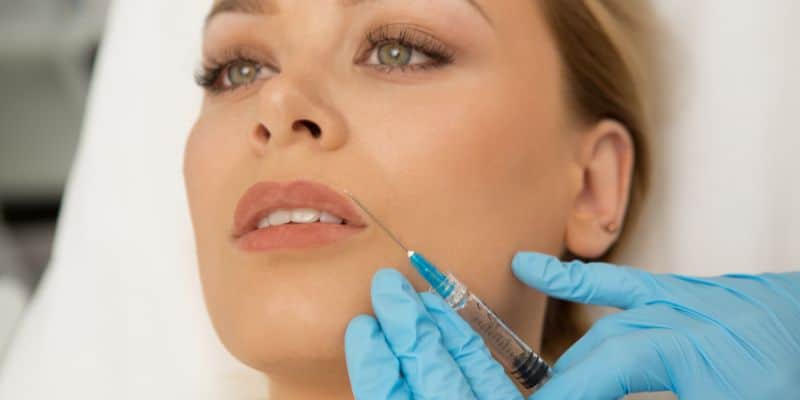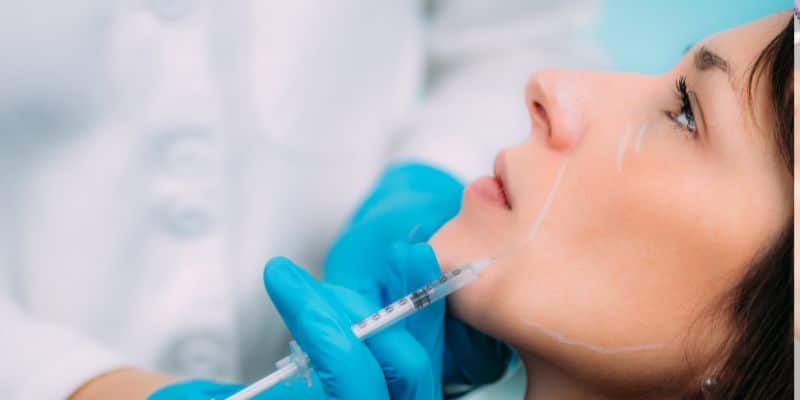
Smile lines, medically known as nasolabial folds, represent the indented lines running from the corners of the nose to the sides of the mouth. They are natural signs of aging that become more prominent with time, often causing significant concern for individuals seeking to maintain a youthful appearance. The aesthetic impact of these facial expressions significantly influences self-perception, interpersonal interactions, and overall quality of life.
In this era of advanced cosmetic procedures, the use of dermal fillers has emerged as a promising solution to address smile lines effectively. These gel-like substances, injected beneath the skin, can restore lost volume, smooth lines, soften creases, and enhance facial contours. The market for dermal fillers has seen a considerable rise due to their efficacy and minimal invasive nature.
The purpose of this article is to provide a comprehensive guide on the use of dermal fillers to treat smile lines. We will explore the science behind dermal fillers, the different types available, and their effectiveness. We’ll also delve into the ethical considerations in the use of dermal fillers and best practices for ensuring patient satisfaction. The information contained herein will serve as a valuable resource for doctors to improve their practices and ensure optimal patient outcomes.
Understanding Smile Lines
Smile lines, medically referred to as nasolabial folds, are a naturally occurring aspect of facial anatomy. They extend from the sides of the nose down to the corners of the mouth and become more pronounced when a person smiles, hence their common name. However, understanding the formation, progression, and the subsequent psychological impact of these lines is crucial for practitioners who are keen on delivering superior aesthetic outcomes for their patients.
A critical point to consider is that smile lines are not strictly a symptom of aging, though they can become more pronounced as patients get older. Factors such as genetics, sun exposure, smoking, and even certain repetitive facial expressions can all contribute to the development and deepening of these lines.
With age, our skin loses its natural elasticity and volume due to the reduction in collagen and elastin production, and the diminishing hyaluronic acid reserves. Additionally, age-related bone resorption can cause changes in facial structure, contributing to the deepening of nasolabial folds. Lifestyle factors like smoking and sun exposure can accelerate this process by damaging skin cells and breaking down collagen and elastin fibers.
These anatomical and physiological transformations are part and parcel of the human aging process. However, from a psychological and societal perspective, pronounced smile lines can have significant impacts on a patient’s self-esteem and confidence. Facial aesthetics have been associated with perceptions of attractiveness, health, and even success in both personal and professional spheres. As such, a substantial number of patients seek aesthetic treatments to address concerns such as smile lines, aiming to rejuvenate their appearance and boost their self-esteem.
Therefore, understanding the multifaceted causes of smile lines allows us, as practitioners, to not only devise effective treatment plans but also to educate our patients. It empowers them to make informed decisions about their treatment and manage their expectations realistically. This patient-centered approach also paves the way for a robust discussion on preventative measures and potential lifestyle changes to complement aesthetic treatments.
A deeper appreciation of the anatomical changes that contribute to smile lines informs our choice of intervention. Dermal fillers offer a minimally invasive and effective solution for treating these lines. They work by restoring lost volume and stimulating collagen production, thereby softening the appearance of these folds and giving a rejuvenated and natural look.
It is worth noting that every patient is unique, with different facial structures, skin types, and aesthetic goals. Therefore, the approach to treating smile lines should be bespoke, tailoring the choice of dermal filler and injection techniques to each individual’s needs. This can be achieved through a thorough understanding of the causes and progression of smile lines, coupled with an in-depth knowledge of the different dermal filler options available.
The Science Behind Dermal Fillers
Dermal fillers, as an integral component of cosmetic dermatology, have emerged as an effective solution for various age-related skin concerns. To provide the most comprehensive and high-quality treatment for patients, it’s imperative that practitioners have a thorough understanding of the science behind these game-changing substances.
At the most basic level, dermal fillers are substances that are injected into the dermis layer of the skin to restore lost volume, smooth lines, soften creases, and enhance facial contours. They work by attracting water molecules, which hydrate, volumize, and structure the skin, promoting a youthful, revitalized appearance. The wide variety of dermal fillers currently available on the market offers an array of options for customizing patient care, each with unique properties and purposes.
One of the most commonly used types of dermal fillers is Hyaluronic Acid (HA). Naturally present in the human body, HA is a vital component of the skin’s structure, providing hydration, fullness, and elasticity. As we age, our bodies produce less HA, leading to a loss of volume and the formation of wrinkles and folds. Injectable HA-based fillers, such as Juvederm and Restylane, mimic the HA found naturally in the body. When injected, they retain water like a sponge, filling in the skin, thus providing volume and structure, and ultimately leading to a more youthful appearance.
Calcium Hydroxylapatite (CaHA), another popular filler material, is a biocompatible substance with a history of use in medicine and dentistry. In the form of a microsphere-based gel (e.g., Radiesse), CaHA provides immediate volume and stimulates the body’s natural collagen production. The body gradually metabolizes the microspheres, leaving behind the naturally produced collagen for long-term improvement.
Poly-L-lactic Acid (PLLA), used in Sculptra, is a synthetic, biodegradable substance that stimulates collagen production over time. It’s often used for deeper wrinkles and volume loss, working gradually over a series of treatments to provide a more subtle, natural-looking result.
The choice of filler depends on the area being treated, the desired outcome, the patient’s personal preferences, and the professional judgement of the practitioner. Each type of filler comes with its own pros and cons and knowing how to optimally use each one is a skill that comes with in-depth understanding and practice.
From a biochemical perspective, the complex interactions between these fillers and human tissues are still being extensively studied. For example, the biointegration of HA fillers involves an intricate interplay between the filler, surrounding tissues, and the immune system. Research has shown that once injected, HA fillers are gradually incorporated into the surrounding tissues through a combination of mechanical anchoring and biochemical interactions.
Similarly, the stimulation of collagen by CaHA or PLLA involves complex processes. For CaHA, it’s hypothesized that the formation of a scaffold by the microspheres provides a structure for fibroblasts to grow and produce collagen. For PLLA, it’s thought that the metabolic process triggers an inflammatory response that stimulates collagenesis.
These intricate biochemical interactions highlight the importance of understanding not only the physical, but also the biological effects of dermal fillers. This knowledge informs better treatment planning, optimizes results, and ensures the safest practice.
Dermal Fillers for Smile Lines
Smile lines, medically known as nasolabial folds, are among the primary facial areas where signs of aging become apparent. Over time, repetitive muscle movement, collagen loss, and subcutaneous fat reduction can cause these lines to deepen, leading to an aged or tired appearance. As medical professionals, we often encounter patients seeking remedies for these lines to regain their youthful look. Among the plethora of aesthetic treatments available, dermal fillers have gained significant traction due to their effectiveness, minimally invasive nature, and quick results.
In essence, dermal fillers serve as a robust tool in our aesthetic arsenal to address smile lines. By injecting fillers into the areas with volume loss, we can smooth out the lines and folds, restoring the skin’s plumpness and giving a more youthful, refreshed appearance. The various types of fillers available, such as Hyaluronic Acid (HA) and Calcium Hydroxylapatite (CaHA), offer us the flexibility to customize treatments according to each patient’s unique needs.
HA fillers, for instance, are frequently used due to their safety, ease of application, and excellent compatibility with the human body, considering HA is a natural component of the skin. They function by drawing in water to add volume and hydrate the skin, making them an ideal choice for softening and plumping up the smile lines. Furthermore, many HA fillers are reversible and temporary, allowing for adjustments if necessary and giving the patient peace of mind knowing the results are not permanent.
Meanwhile, CaHA fillers have microspheres suspended in a water-based gel, offering instant volume upon injection and stimulating collagen production over time. These fillers, such as Radiesse, can provide longer-lasting results, making them suitable for patients desiring extended benefits.
The effectiveness of dermal fillers in treating smile lines is backed by numerous case studies and clinical data. For instance, a study published in the Journal of Clinical and Aesthetic Dermatology reported high patient satisfaction levels and notable improvement in nasolabial fold severity scores following HA filler treatments. Similarly, research in Dermatologic Surgery demonstrated substantial longevity of CaHA fillers, with about 75% of patients maintaining improvement at 12 months post-treatment.
Choosing the right type of filler, however, depends on various factors. It’s critical to evaluate each patient’s skin type, the severity of their smile lines, their desired outcomes, and their readiness for the upkeep (as some fillers require more frequent touch-ups than others). A thorough consultation can help determine the most appropriate treatment plan, ensuring both safety and satisfaction.
Dermal fillers are more than just a cosmetic procedure; they play a vital role in enhancing self-esteem and overall life satisfaction for our patients. A survey published in the Journal of Cosmetic Dermatology found that injectable treatments, such as dermal fillers, led to increased self-confidence and perceived age reduction in patients, underlining the value of these treatments beyond superficial aesthetics.

Procedure of Injecting Dermal Fillers
For medical practitioners, the mastery of the injection technique for administering dermal fillers is a requisite that defines the quality of treatment and ultimate aesthetic outcome for the patient. With a keen focus on the treatment of smile lines, this article provides a step-by-step guide to the injection process, details the strategies for pain management during the procedure, and highlights the imperative of post-procedure care and follow-ups.
- Patient Assessment and Marking: Before commencing with the injection process, a thorough assessment of the patient’s facial anatomy and the severity of the smile lines is essential. This provides crucial insights into the quantity and type of filler required and the ideal injection sites. Photographs of the patient’s face at rest and in motion should be taken for documentation and further analysis. Markings can then be made on the skin surface to indicate the precise locations for filler placement.
- Preparation and Anesthesia: The next step is to prepare the dermal filler as per the manufacturer’s instructions. The injection area is cleaned and disinfected to mitigate infection risk. Topical or local anesthesia is administered to alleviate any discomfort during the procedure. Anesthetics such as lidocaine are often included in many dermal filler preparations.
- Filler Injection: With the patient in a semi-reclined position, the dermal filler is carefully injected using either a needle or cannula, depending on the provider’s preference and the specifics of the treatment area. The needle is inserted at the marked points, and the filler is injected in a retrograde manner, meaning the substance is released while pulling the needle back. The technique can be linear threading, fanning, cross-hatching, or serial puncture depending upon the area and the depth of the smile lines.
- Massage and Mold: Once the filler is in place, it may need to be massaged or molded to distribute it evenly and reduce any visible lumps. This ensures a more natural and smooth result, enhancing the efficacy of the treatment.
- Post-Injection Protocol: Immediately after the injection, the treated area is cleaned, and an ice pack is applied to minimize swelling and bruising. The patient should be advised to avoid rigorous exercise, hot baths, saunas, or direct sun exposure for at least 24 hours post-procedure.
- Follow-up and Aftercare: The patients should be scheduled for a follow-up appointment about two weeks after the treatment. This allows the practitioner to assess the results, address any complications, and determine if any touch-ups are necessary. Regular follow-ups ensure that any adverse events are caught early and managed promptly.
The process of injecting dermal fillers to address smile lines requires precision, medical knowledge, and aesthetic judgment. Ensuring patient comfort during the procedure and educating them about post-procedure care is equally important for achieving the desired results. Practitioners must remain up-to-date with the latest techniques and advancements to deliver the safest and most effective treatment to their patients.
Remember, each patient is unique, and their treatment plan should be personalized based on their specific needs and aesthetic goals. By following this comprehensive procedure for injecting dermal fillers, practitioners can optimize outcomes and ensure a more satisfactory smile line treatment experience for their patients.
Potential Side Effects and Complications
In any medical procedure, the acknowledgment of potential side effects and complications is not just a regulatory mandate, but also a fundamental cornerstone of responsible medical practice. As practitioners who purchase and utilize dermal fillers, understanding these risks is integral to informing our patients and implementing the most effective management strategies. While dermal fillers have generally proven to be safe and effective, like all treatments, they are not without potential complications.
Immediate side effects typically associated with dermal filler injections can be mild and temporary. These commonly include localized reactions such as redness, swelling, pain, bruising, itching, and tenderness at the injection site. These are generally self-limiting and resolve within a few days to a week.
Allergic reactions to dermal fillers are uncommon due to the biocompatible nature of most modern filler substances like hyaluronic acid. However, when they do occur, they can manifest as prolonged swelling, redness, or even hives. In such cases, appropriate management, including potential use of antihistamines or corticosteroids, may be required.
There are also complications that, while rare, are more serious and demand immediate medical attention. Vascular occlusion, a particularly dreaded complication, can occur if the filler is accidentally injected into a blood vessel. It can cause skin necrosis or, in extremely rare cases, blindness. Understanding facial anatomy, using the correct injection techniques, and having a swift response plan is essential to avoid and manage such scenarios. Hyaluronidase, an enzyme that breaks down hyaluronic acid, should be readily available in the clinic when using hyaluronic acid fillers, as it can quickly dissolve the filler in the event of vascular occlusion.
Another rare but serious complication is the formation of granulomas, which are small nodules that can form at the injection site. They might not appear until weeks or even months after the treatment and might require corticosteroid treatment or surgical removal.
Infections are also a risk, though strict adherence to proper aseptic techniques can significantly minimize this risk. When infections do occur, they usually present as persistent redness and swelling, and might require antibiotic treatment. In the event of a severe infection, biofilms could form, and a referral to a specialist might be necessary.
Late-onset adverse events can also occur and are often associated with the stimulation of the immune system. These include delayed hypersensitivity reactions, the aforementioned granulomas, or migration of the filler substance from the original site. These instances might require medical interventions, including systemic steroids or filler dissolution.
To minimize these potential side effects and complications, proper patient selection, comprehensive knowledge of facial anatomy, choosing the correct filler, mastering appropriate injection techniques, and meticulous aftercare are fundamental. Equally important is educating our patients about these potential risks, no matter how minimal. An open discussion about the pros and cons of the procedure allows patients to make an informed decision and sets realistic expectations. This can also build a trusting doctor-patient relationship, which plays a significant role in patient satisfaction.
Ethical Considerations in the Use of Dermal Fillers
As medical practitioners, we operate within an ethical framework that guides our interactions with patients. This framework becomes even more significant when using treatments such as dermal fillers, where subjective elements such as aesthetic appeal and personal confidence interplay with medical intervention. The critical ethical considerations in the use of dermal fillers for treating smile lines encompass three main aspects: setting realistic expectations, ensuring patient autonomy, and implementing informed consent.
Firstly, setting realistic expectations is paramount. As physicians, it’s essential to have an open dialogue with patients regarding what can and cannot be achieved with dermal fillers. Not every patient’s smile lines can be completely eradicated, and this reality needs to be communicated transparently. Physicians should avoid the temptation to promise optimal results for all, given the diversity in skin types, age, lifestyle, and physiological responses to the treatment.
Secondly, patient autonomy must be respected in all stages of treatment. While doctors can suggest and recommend, the final decision should always rest with the patient. Patients might feel pressured by societal beauty standards or their insecurities to opt for dermal fillers, but our role is not to exploit these insecurities but to ensure they’re making informed decisions for themselves. It’s crucial to reassure patients that opting out or delaying the treatment does not affect their continuity of care or the doctor-patient relationship.
Thirdly, informed consent is not just a legal requirement but an ethical one as well. It represents a tangible commitment to respecting patient autonomy and promoting patient-centered care. For consent to be valid, it must be voluntary, the patient must be competent, and the information provided must be adequate and understood. In the context of dermal fillers, patients must be made aware of the potential risks, benefits, and alternatives to the proposed treatment. This information needs to be communicated in a language and manner that the patient can understand, giving them ample time to ask questions and consider their options.
It is also essential to discuss the potential side effects and complications associated with the procedure, emphasizing that while dermal fillers are generally safe, adverse reactions can occur. Being open about these possibilities is not about instilling fear, but about fostering trust and ensuring patients are not blindsided if complications do arise.
Additionally, we should also address the aspect of financial ethics in our practice. While dermal fillers represent a revenue stream, it’s crucial not to let commercial interests override our professional judgment. Procedures should be recommended based on their necessity and the likely benefit to the patient, rather than their profitability.
Finally, considering the increasing popularity and easy availability of dermal fillers, a heightened sense of responsibility rests on our shoulders to ensure these procedures are used judiciously and not trivialized as routine beauty treatments. There should be a clear demarcation between medical interventions and beauty enhancements.
Conclusion
In conclusion, the versatility and efficacy of dermal fillers for addressing smile lines make them an invaluable tool in aesthetic medicine. By comprehensively understanding the science behind these fillers, their application, potential side effects, and ethical implications, we can harness their full potential while mitigating risks. This allows us to consistently meet our patients’ needs, improving their aesthetic outlook and, subsequently, their self-esteem and quality of life. Furthermore, it’s essential to communicate openly with our patients, managing their expectations and providing a clear understanding of the treatment process. Through such practices, we build trust and satisfaction in our patient relationships. As the field of dermal fillers continues to evolve, remaining abreast of new developments will be key to ensuring the best patient outcomes and maintaining a competitive edge in the aesthetics market. The future of smile line treatment, undoubtedly, will have dermal fillers at its core.

Doris Dickson is an expert voice on cosmetic medical treatments and products, writing for Health Supplies Plus, a premier online resource for the medical community. Her concise, no-nonsense takes spotlight the tools and techniques shaping modern aesthetics.


